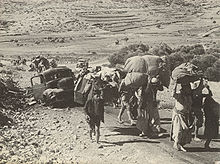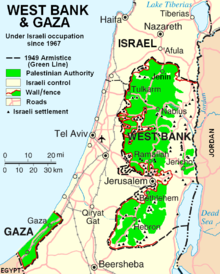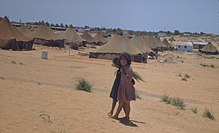Israeli-Palestinian conflict

The Israeli-Palestinian conflict forms the core of the Middle East conflict over the Palestine region that arose between Jews and Arabs at the beginning of the 20th century . It is about the country, the security of borders and the statehood of two nations.
Development of the conflict
Historical development of the conflict
The current conflict in the region can be traced back in particular to the clashes between Arab and Jewish national movements, but also before the British mandate . The Zionist movement, which took shape mainly as a result of the ongoing persecution of Jews, caused large waves of Jewish immigration ( aliyah ) with the aim of finally ending the centuries-old diaspora in Palestine. However, this led to a growing conflict between Arabs and Jews in the region, both of whom saw Palestine as their rightful homeland.
The cornerstones of the conflict are the failed UN partition plan of 1947 , the Palestinian War in 1948 and a resulting refugee problem on both the Arab and Jewish sides (see Palestinian refugee problem ). Around 750,000 Jews were expelled from Arab states and mostly became Israeli citizens, while a similar number of Palestinian Arabs were expelled from Israel / Palestine and fled to surrounding Arab states. Their descendants, which are now around 5 million registered, mostly live as stateless persons in Jordan, Lebanon and Syria , a third of them in official refugee camps , because they are denied citizenship .
This was followed by the Six Day War in 1967 , the Yom Kippur War in 1973 , the development of a Palestinian national consciousness primarily through the establishment of the PLO , which was officially recognized by the United Nations in 1974 as the “representative of the Palestinian people” and the institution the Palestinian Autonomous Territories, which are still not recognized as a state under international law . The conflict with Israel , which continues to this day, resulted from the diplomatic and armed striving of the Palestinians for a nation-state as granted to them in the UN partition plan . Palestinian organizations strive for different goals. The Fatah as the strongest faction of the PLO seeks a two-state solution, radical Islamic terrorist organizations such. B. Hamas, however, the destruction of Israel and a Palestinian or pan-Arab state, which should extend at least over today's Israel, the Gaza Strip and the West Bank.
The violent conflicts that took place between Israel and Palestinian organizations include the first and second intifada . Palestinian organizations and the Israeli army were also involved in various other military conflicts and wars in which they fought against each other prior to the intifadas, particularly in 1978 and 1982 during the decades-long Lebanese civil war . In addition, the violent conflict is characterized by ongoing asymmetrical warfare . The Israeli army responded to terrorist attacks by the Palestinians on civilian targets, including suicide attacks , with the military operations Operation Cast Lead 2008 and Operation Protective Edge 2014, which resulted in numerous civilian casualties among the Palestinians and are therefore controversial with regard to their necessity and proportionality.
Attempted solutions
There have been and are many attempts to resolve the conflict peacefully. The Oslo Agreement of 1993 raised high hopes, which , in addition to mutual recognition by the PLO and Israel, provided for the withdrawal of the Israeli army from the West Bank and the Gaza Strip and Palestinian self-government in these areas. After a transition period, a permanent status of the areas should be negotiated. However, this “ Oslo peace process ” stalled after no agreement was reached at a meeting between PLO leader Arafat and Israeli Prime Minister Barak in 2000 at Camp David . Since the outbreak of the second intifada, the peace process has been considered a failure.
Gaza Strip
The Israeli settlements in the Gaza Strip were evacuated by the Israeli army in 2005 , and the military also withdrew completely from the area. However, Israel has maintained a blockade on the border and off the coast since Hamas' violent takeover of the Gaza Strip in 2007 .
In particular, the radical Islamist Hamas, which is calling for the complete annihilation of Israel, is fueling the conflict by, among other things, regularly bombarding Israel with Qassam rockets and through terrorist attacks. It consists of the paramilitary Qassam brigades , but also a charitable network and a political party, which makes it difficult to classify them clearly. She is also a member of the Muslim Brotherhood , which also includes the former Egyptian President Mohammed Morsi , who most recently played a mediating role. Internationally, however, Hamas is sometimes classified as a terrorist organization . Since taking power in the Gaza Strip in 2007, Hamas has repeatedly executed people it accused of collaborating with Israel.
West Bank
The West Bank is occupied by the Israeli army and surrounded by a barricade , around 85% of which runs within the West Bank and around 15% directly along the Green Line . There are 133 Israel-supported Jewish settlements with 448,672 inhabitants that are controversial under international law (as of 2018).
Palestinians in the West Bank lament social and political disadvantages resulting from the occupation , such as restrictions on freedom of movement and unequal supplies of food and water, while Israel points out that it supplies the West Bank with far more water than in the Oslo Accords intended.
In recent years, Islamist organizations such as Hamas have gained popularity among sections of the Palestinian population. They oppose the policies of the Palestinian Authority and Fatah , which they consider to be too moderate. While Fatah has officially ended the military struggle against Israel and is building on diplomatic solutions, Hamas and radical factions are continuing the armed struggle using terrorist means.
Fatalities since 1948
Different studies indicate different numbers of victims for the Israeli-Palestinian conflict. According to the Stockholm International Peace Research Institute , 13,000 Israelis and Palestinians were killed as a direct result of the conflict between 1948 and 1997. Other estimates assume 14,500 deaths between 1948 and 2009.
See also
- Israeli peace diplomacy
- House demolition in the Israeli-Palestinian conflict
- Fatah-Hamas conflict
- Israeli settlement construction in the Palestinian Territories
literature
- Muriel Asseburg , Jan Busse: The Middle East Conflict. History, positions, perspectives . Verlag CHBeck, Munich 2016, ISBN 978-3-406-69776-0 .
- From Politics and Contemporary History 9/2010: Middle East Conflict .
- Martin Beck: Peace Process in the Middle East. Rationality, cooperation and political rent in the Middle East . Wiesbaden: Westdeutscher Verlag, 2002, ISBN 3-531-13724-7 .
- Conor Cruise O'Brien : State of Siege. The history of the state of Israel and Zionism (Original title: "The Siege: The Saga of Israel and Zionism"), ISBN 978-3-85445-033-7 (Original: ISBN 978-0-671-63310-3 ).
- Noah Flug , Martin Schäuble: The History of the Israelis and Palestinians. With maps, timetable and media information . Munich, updated edition 2009, ISBN 978-3-423-62416-9 .
- Motti Golani: From Civil War to Interstate War and Back again. The War over Israel / Palestine, 1945-2000 , in: Zeithistorische Forschungen / Studies in Contemporary History 2 (2005), pp. 54–70.
- Margret Johannsen: The Middle East Conflict , VS Verlag für Sozialwissenschaften, Wiesbaden 2006, ISBN 3-531-15243-2 .
- Gernot Rotter , Schirin Fathi: Middle East Lexicon. The Israeli-Palestinian conflict from A – Z , Palmyra Verlag, Heidelberg 2001, ISBN 3-930378-28-0 .
- Rolf Steininger : The Middle East Conflict , Fischer-Kompakt, Frankfurt am Main 2003, 4th edition 2006, ISBN 3-596-16121-5 .
- Dieter Vieweger : Controversy about the Holy Land - What everyone should know about the Israeli-Palestinian conflict , Gütersloher Verlagshaus, Gütersloh, 3rd revised and updated edition, 2011, ISBN 978-3-579-06757-5 .
Web links
Individual evidence
- ^ Margret Johannsen, 2009: The Middle East Conflict. Elements of politics: textbook, Springer Verlag, ISBN 3-531-16690-5 , ISBN 978-3-531-16690-2 . P. 11
- ↑ Dietmar Herz, Christian Jetzlsperger, Kai Ahlborn (ed.) 2003: The Israeli-Palestinian conflict: Backgrounds, dimensions and perspectives. Volume 48 of Historical Communications - Supplements Series. Franz Steiner Verlag, ISBN 3-515-08259-X , ISBN 978-3-515-08259-4 , p. 8
- ^ Palestine refugees. United Nations Relief and Works Agency for Palestine Refugees in the Near East, accessed October 16, 2017 .
- ^ Bernhard Chiari, Dieter H. Kollmer, Martin Rink (eds.): Middle East. 2nd, revised and expanded edition. Schöningh, Paderborn u. a. 2009, ISBN 978-3-506-76759-2 , p. 121.
- ↑ Khaled Abu Toameh: "Hamas Executes former B'Tselem fieldworker" , The Jerusalem Post , January 25 of 2009.
- ^ “Hamas executes two suspected Israeli spies” ( Memento November 12, 2014 in the Internet Archive ), Daily News / AP, April 15, 2010.
- ↑ “ Hamas executes Palestinians convicted of collaboration, ” BBC , July 26, 2011.
- ↑ "World Report 2012: Israel / Occupied Palestinian Territories" , Human Rights Watch .
- ↑ “Hamas: 3 executed in Gaza, one for 'collaborating' with Israel” , CNN , April 7, 2012.
- ↑ Jodi Rudoren and Fares Akram: "Suspected Collaborator With Israel Killed on Gaza Street" , The New York Times , 16 November 2012 found.
- ↑ Tania Krämer: Israel is fencing in more and more. In: Deutsche Welle. April 30, 2013, accessed November 3, 2019 .
- ↑ The growth rate of settlers has decreased. In: Israelnetz .de. January 8, 2019, accessed January 19, 2019 .
- ↑ Amnesty International: Israel Denies Palestinians Access to Water
- ↑ Klaus Polkehn: The water and the question of Palestine
- ↑ Due to current events: Explanations on the water issue in the Middle East conflict . Embassy of the State of Israel in Berlin. February 13, 2014. Retrieved February 15, 2014.
- ↑ a b Twentieth Century Atlas - Death Tolls. RCN DC Metro . December 2005.
- ↑ "All wars in the 20th century." The Polynational War Memorial .


